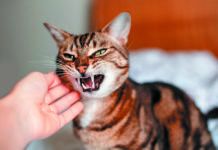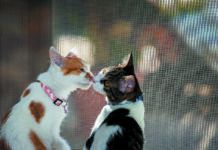[From Tufts March 2012 Issue]
[Editor’s note: Nicholas Dodman, BVMS, director of the Animal Behavior Clinic at Cummings School of Veterinary Medicine at Tufts University, is a renowned animal behaviorist and best-selling author. This is part of an occasional series on some of his most compelling cases.]
Frustrated and perplexed as to why her cat Caleb was chewing and ingesting non-food items, Stephanie Billingham, PhD, a psychologist, came to me for help. She couldn’t seem to stop this 4-year-old blue point Siamese from eating part of the cuff from a pair of pants, chewing holes in socks and t-shirts and curiously, consuming wrappers.
This condition, known as pica, is closely related to — and is sometimes an extension of — feline wool-sucking. In fact, some people refer to the condition as wool-sucking/pica. Most prevalent in Oriental breeds of cat, in particular Siamese cats, wool-sucking often starts when cats are only a matter of months old and consists of mouthing and chewing on woolen materials. It is usually accompanied by kneading or treading with the forepaws, and is sometimes associated with salivation. Wool-sucking is thought to be a displaced suckling behavior and is, therefore, a form of a disorder akin to thumb-sucking in children.
As you’ll notice from Caleb’s case, however, not all the items that these cats choose to suckle on, chew or swallow are actually wool (though wool does feature prominently in the aberrant diet of affected cats). Other typical substrates on which wool-sucking cats chew are acrylic, plastic, shoelaces, running gear (shorts and vests), sometimes newspaper and even the plastic surrounding electric wires. Luckily, Caleb didn’t have all of these items in his texture-specific diet.
These days, wool-sucking/pica is regarded as a form of feline compulsive disorder and, as such, has genetic underpinnings, evidenced by the fact that it typically affects Oriental breeds of cat. We have plotted out the family tree of affected cats and can follow the inheritance from generation to generation. Treatment of obsessive-compulsive disorder in people involves cognitive therapy and/or pharmacotherapy (the use of anti-obsessional medication). In domestic animals, we do not have the luxury of cognitive therapy as we can’t talk to them and explain why they should not engage in it. However, we do have one non-pharmacological option available to us — environmental enrichment — and if this is conducted properly, it can go a long way toward attenuating the condition, especially if used along with pharmacotherapy…at least for a while.
Why Should You Treat Pica in Cats?
Why would you want to treat wool-sucking/pica in a cat, you might ask? The reason is that not only is this condition sometimes extremely destructive — Dr. Billingham had spent thousands of dollars replacing and repairing her clothes — but it is also extremely dangerous for the cat because it can lead to intestinal obstruction, which in turn may have fatal consequences. In Caleb’s case, as part of the environmental enrichment plan, we made sure he had continuous access to a high-fiber dry cat food (Purina OM), and increased his activity level by having Dr. Billingham exercise him daily using various moving toys and flash lights/lasers. I also instructed her to leave treat balls containing various tasty snacks around her house and to provide fish treats for him frozen in ice cubes.
We also initiated treatment of Prozac, slowly inching the dose up to a therapeutic level so as to avoid side effects. The result was nothing short of spectacular. After a few weeks, Caleb’s eating of non-edible items was dramatically reduced and eventually, after many months, it ceased entirely.
We continued the Prozac treatment as well as environmental enrichment for Caleb for close to a year before Dr. Billingham decided to risk taking him off the medication. Four months after the Prozac was discontinued, Dr. Billingham called us to report that Caleb still hadn’t shown any interest in non-food items, but she did note that his general hunger had increased and he tended to vocalize, demanding more food after finishing a meal or a snack. We reminded Dr. Billingham that food should be constantly available to Caleb, and since he was not overweight, this was not likely to be an issue.
Not all cats respond as well as Caleb to environmental enrichment and treatment with a drug like Prozac. Some show an acceptable degree of improvement, but will occasionally succumb to the odd woolen sock or other clothing item. This was the case with Dr. Billingham’s other two cats — also Siamese, also wool-suckers — who did not respond as dramatically as Caleb. One of them was such a hard-core wool-sucker that he would bite his way into places — drawers, closets — and even managed to open a fridge door secured by a child-lock device, seemingly unimpaired by his lack of opposable thumbs.
At one time it was thought that wool-sucking could be addressed by simply providing cats more roughage. In Caleb’s case, he was switched to a high-fiber diet. Veterinarians used to recommend feeding wool-sucking cats raw chicken wings or necks, but this is not safe because such rations can lead to intestinal obstruction, and raw food is a potential source of infection. Proprietary high-fiber food is far more acceptable, but on its own rarely does the trick.
Caleb was one of the first cats to be enrolled in what is an ongoing study of the genetics of wool-sucking/pica in Siamese and Burmese cats at Cummings School of Veterinary Medicine at Tufts University. The study has been going slowly because owners are reluctant to volunteer their cats for blood sampling, which is a little bit trickier in a cat than a dog. However, the technology has improved, and we are now able to offer genetic sampling by means of a cheek swab.
Pretty soon, as we have done with dogs, we may be able to identify the precise genetic glitch in Oriental cats that leads to this insatiable appetite for certain inedible items. It is our hope that the discovery would lead to better understanding of the mechanisms involved and lead to the development of new treatments, both for cats and possibly, humans.




I have a one year old domestic short hair black cat who chews and eats pieces of polyethylene plastic bags. I mentioned this to the Veterinarian I use for my cats and your recommendation for Prozac. He did not feel that was an appropriate treatment but had no other solution than elimination of the plastic in places accessible to the cat. That is pretty hard to do in todays home environment as I use these bags for waste can liners and litter disposal bags. I am aware that petroleum based bags such as this can ultimately be fatal. Do you have another solution? He has been raised as an indoor pet as I have lost more than a dozen to indoor/outdoor cats to coyotes?
i have a 1.5 year old male bengal who eats so many things from shoelaces , plastic bags, silicone, dishtowels, pillow cases, 1/2 tshirt sleeve, any strings from pajama pants, most cat toys along with plants he has been medically cleared from any conditions and is about to try a treatment of prozac and i will also add as much enrichment as he eats most things so i am limited to toys so he gets bored easily. i have added in a treat ball filled with kibble and has tried clomicalm with no help and will be starting prozac on the 14th. He eats raw food but have added kibble in his treat ball. He has access to a cat wheel. I cant leave food out at all time due to other animals and he would be huge from eating.
Any other suggestions would be greatly appreciated.